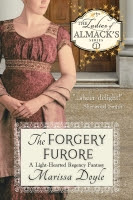 Some of you will remember a series I did a while ago at QNPoohBear's suggestion of real-life nineteenth century ladies who were
inspiring enough to be heroines in a book.
We talked about Caroline Herschel’s stargazing,
Ada Byron’s mathematical computing,
and Mary Anning’s dinosaur hunting. I recently stumbled upon another lady I
simply had to add to the list: the
commander of Napoleon’s balloon army, Sophie Blanchard.
Some of you will remember a series I did a while ago at QNPoohBear's suggestion of real-life nineteenth century ladies who were
inspiring enough to be heroines in a book.
We talked about Caroline Herschel’s stargazing,
Ada Byron’s mathematical computing,
and Mary Anning’s dinosaur hunting. I recently stumbled upon another lady I
simply had to add to the list: the
commander of Napoleon’s balloon army, Sophie Blanchard.
You wouldn’t think ballooning would be a career for a lady
in the late eighteenth, early nineteenth century, much less leading a squadron
of armed forces for a major power. Sophie
was one of a handful of women who ventured up in balloons, and one of the only
ones skilled enough to go up alone. Born
in 1778 in France, Sophie was a nervous girl who disliked riding in carriages
and startled at loud noises. We don’t
know a great deal about her early life, but somewhere between the ages of 16
and 26, she married one of the premiere balloonists of the day, Jean-Pierre
Blanchard.
Jean-Pierre was a showman who had already toured Europe and
America, helped pioneer the parachute, and set records around the world. Unfortunately, he hadn’t a lick of business
sense and was always in debt. In hopes
of recovering, he added Sophie to his act, and the two were popular sights for
coronations, royal birthdays, the opening of major buildings, and the like. Sophie was undaunted by the dangers of
balloon flight, claiming at one point that she’d rather sleep in a balloon than
on land. She flew high enough that she
nearly passed out from lack of oxygen, she risked freezing at the cold
temperatures aloft, and once she almost drown when her balloon landed in a
swamp.
 She performed so many times for Napoleon, both with her
husband and solo, that he made her the Aeronaut of Official Festivities. Determined to reach England by any way
possible, he also appointed her the Chief Air Minister of Ballooning and asked
her to draw up plans for how he could fly his army over the Channel to
attack. Sophie is reported to have had
little faith in the venture. Balloons at
that time had few ways to control them, and she recognized, even if Napoleon
did not, that the wind generally blew the wrong way.
She performed so many times for Napoleon, both with her
husband and solo, that he made her the Aeronaut of Official Festivities. Determined to reach England by any way
possible, he also appointed her the Chief Air Minister of Ballooning and asked
her to draw up plans for how he could fly his army over the Channel to
attack. Sophie is reported to have had
little faith in the venture. Balloons at
that time had few ways to control them, and she recognized, even if Napoleon
did not, that the wind generally blew the wrong way.
Tragedy struck the couple in 1809 when Jean-Pierre had a
heart attack while performing and fell from his balloon to his death. Sophie, however, continued to perform. Despite the fact that she was afraid of loud
noises, she perfected an act in which she lighted fireworks and tossed them by
parachute from her balloon to the delighted crowds below. Her vehicle of choice was a hydrogen-filled
balloon with a tiny basket below. She
flew to celebrate the marriage of Napoleon to Marie-Louise of Austria in 1810
and on Napoleon’s 42nd birthday in 1811.
She flew over Paris and threw down leaflets proclaiming the birth of
Napoleon’s son. She also performed in
Germany, Rome, and the Alps.
I wish I had a happy ending for you. Unfortunately, it seems Sophie and Jean-Pierre had no
children, or at least none that survived beyond infancy. In July 1819, Sophie was performing at the Tivoli
Gardens in Paris when her balloon caught fire and she too fell to her death,
entangled in the cords of her basket.
All proceeds from the event were used to build her a monument in a Paris
cemetery.
But Sophie wasn’t forgotten.
Jules Vernes mentioned her in Five
Weeks in a Balloon, proving that, nearly 50 years after her death, her
amazing accomplishments lived on.





2 comments:
Awesome! I love reading about real life heroines. Sophie is the heroine of a novel: The Little Balloonist by Linda Donn. or at least her Sophie is based on the real Sophie. I think the real life Sophie sounds more interesting than the character in the novel. The history was great but the plot not so much.
Thanks, QNPoohBear! And thanks for mentioning Linda Donn's book. I saw it somewhere along the line when I was researching the post and forgot it before I finished! I must admit I found her fascinating--so fearful on the ground, and so fearless in the air!
Post a Comment